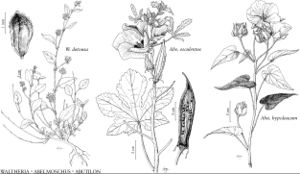Difference between revisions of "Abelmoschus esculentus"
Methodus, 617. 1794.
FNA>Volume Importer |
imported>Volume Importer |
||
| (3 intermediate revisions by 2 users not shown) | |||
| Line 10: | Line 10: | ||
|special_status={{Treatment/ID/Special_status | |special_status={{Treatment/ID/Special_status | ||
|code=F | |code=F | ||
| − | |label= | + | |label=Illustrated |
}}{{Treatment/ID/Special_status | }}{{Treatment/ID/Special_status | ||
|code=I | |code=I | ||
| Line 21: | Line 21: | ||
|name=Hibiscus esculentus | |name=Hibiscus esculentus | ||
|authority=Linnaeus | |authority=Linnaeus | ||
| + | |rank=species | ||
|publication_title=Sp. Pl. | |publication_title=Sp. Pl. | ||
|publication_place=2: 696. 1753 | |publication_place=2: 696. 1753 | ||
| Line 39: | Line 40: | ||
|elevation=0–30 m | |elevation=0–30 m | ||
|distribution=Fla.;Ga.;La.;Miss.;N.C.;S.C.;Va.;s Asia;Africa;sw Pacific Islands;introduced also in Mexico and elsewhere nearly worldwide. | |distribution=Fla.;Ga.;La.;Miss.;N.C.;S.C.;Va.;s Asia;Africa;sw Pacific Islands;introduced also in Mexico and elsewhere nearly worldwide. | ||
| + | |introduced=true | ||
|discussion=<p><i>Abelmoschus esculentus</i> is a cultigen, apparently domesticated in India for the edible, unripe, succulent, mucilaginous young capsule and edible leaves; it may escape from commercial and garden cultivation and sometimes persist in waste places.</p> | |discussion=<p><i>Abelmoschus esculentus</i> is a cultigen, apparently domesticated in India for the edible, unripe, succulent, mucilaginous young capsule and edible leaves; it may escape from commercial and garden cultivation and sometimes persist in waste places.</p> | ||
|tables= | |tables= | ||
| Line 48: | Line 50: | ||
-->{{#Taxon: | -->{{#Taxon: | ||
name=Abelmoschus esculentus | name=Abelmoschus esculentus | ||
| − | |||
|authority=(Linnaeus) Moench | |authority=(Linnaeus) Moench | ||
|rank=species | |rank=species | ||
| Line 63: | Line 64: | ||
|publication title=Methodus, | |publication title=Methodus, | ||
|publication year=1794 | |publication year=1794 | ||
| − | |special status= | + | |special status=Illustrated;Introduced;Weedy |
| − | |source xml=https:// | + | |source xml=https://bitbucket.org/aafc-mbb/fna-data-curation/src/2e0870ddd59836b60bcf96646a41e87ea5a5943a/coarse_grained_fna_xml/V6/V6_386.xml |
|subfamily=Malvaceae subfam. Malvoideae | |subfamily=Malvaceae subfam. Malvoideae | ||
|genus=Abelmoschus | |genus=Abelmoschus | ||
Latest revision as of 22:20, 5 November 2020
Plants 1–2 m. Stems often red blotched, coarse. Leaf blades scarcely lobed to palmately divided, 10–25 cm, ± broader than long. Pedicels not articulated, stout; involucellar bractlets linear, to 2.5 cm. Flowers: corolla to 8 cm diam.; staminal column anther-bearing from near base, apex 5-toothed. Capsules cylindric, slightly 5-angled, beaked, 8–30 cm. 2n = 72, 108, 118, 120, 122, 130, 132, 144.
Phenology: Flowering spring–fall.
Habitat: Fertile, well-drained soil with ample moisture, waste places
Elevation: 0–30 m
Distribution

Introduced; Fla., Ga., La., Miss., N.C., S.C., Va., s Asia, Africa, sw Pacific Islands, introduced also in Mexico and elsewhere nearly worldwide.
Discussion
Abelmoschus esculentus is a cultigen, apparently domesticated in India for the edible, unripe, succulent, mucilaginous young capsule and edible leaves; it may escape from commercial and garden cultivation and sometimes persist in waste places.
Selected References
None.
